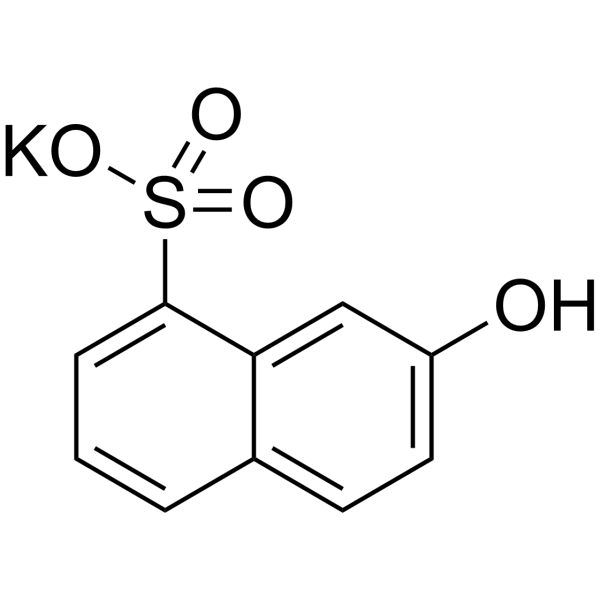
Potassium 7-hydroxy-1-naphthalenesulfona
CAS No. 30252-40-5
Potassium 7-hydroxy-1-naphthalenesulfona( 2-Naphthol-8-sulfonic Acid Potassium Salt )
Catalog No. M29440 CAS No. 30252-40-5
Potassium 7-hydroxy-1-naphthalenesulfona is naturally present in the fruit of the Rubiaceae gardenia, the flowers of the Iridaceae crocus, and the flowers and leaves of the Scrophulariaceae Scrophulariaceae.
Purity : >98% (HPLC)
 COA
COA
 Datasheet
Datasheet
 HNMR
HNMR
 HPLC
HPLC
 MSDS
MSDS
 Handing Instructions
Handing Instructions
| Size | Price / USD | Stock | Quantity |
| 50MG | 45 | Get Quote |


|
| 100MG | Get Quote | Get Quote |


|
| 200MG | Get Quote | Get Quote |


|
| 500MG | Get Quote | Get Quote |


|
| 1G | Get Quote | Get Quote |


|
Biological Information
-
Product NamePotassium 7-hydroxy-1-naphthalenesulfona
-
NoteResearch use only, not for human use.
-
Brief DescriptionPotassium 7-hydroxy-1-naphthalenesulfona is naturally present in the fruit of the Rubiaceae gardenia, the flowers of the Iridaceae crocus, and the flowers and leaves of the Scrophulariaceae Scrophulariaceae.
-
DescriptionPotassium 7-hydroxy-1-naphthalenesulfona is naturally present in the fruit of the Rubiaceae gardenia, the flowers of the Iridaceae crocus, and the flowers and leaves of the Scrophulariaceae Scrophulariaceae.
-
In Vitro——
-
In Vivo——
-
Synonyms2-Naphthol-8-sulfonic Acid Potassium Salt
-
PathwayOthers
-
TargetOther Targets
-
Recptor——
-
Research Area——
-
Indication——
Chemical Information
-
CAS Number30252-40-5
-
Formula Weight262.32
-
Molecular FormulaC10H7KO4S
-
Purity>98% (HPLC)
-
Solubility——
-
SMILES[K+].Oc1ccc2cccc(c2c1)S([O-])(=O)=O
-
Chemical Name——
Shipping & Storage Information
-
Storage(-20℃)
-
ShippingWith Ice Pack
-
Stability≥ 2 years
Reference
molnova catalog



related products
-
Nitarsone
Nitarsone is an organoarsenic compound that is used in poultry production as a feed additive to increase weight gain improve feed efficiency and prevent blackhead disease.
-
4-Methyl-2-pentanone
4-Methyl-2-pentanone is an organic solvent. It is occasionally found as a volatile component of urine. It in urine is considered a biological marker of occupational exposure to this solvent.
-
1-Oleoyl-rac-glycero...
1-O-Oleyl-rac-glycerol also known as monoolein is a surfactant that releases free glycerol and oleic acid upon hydrolysis.



 Cart
Cart
 sales@molnova.com
sales@molnova.com


